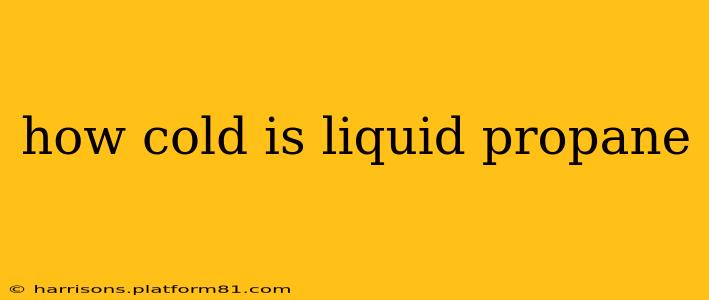Liquid propane, a crucial fuel source for various applications, exists at a significantly lower temperature than its gaseous counterpart. Understanding this temperature is vital for safe handling, efficient use, and appreciating its diverse applications. This article delves into the specifics of liquid propane's temperature, addressing common questions and misconceptions.
What is the Boiling Point of Propane?
The key to understanding how cold liquid propane is lies in its boiling point. At standard atmospheric pressure (1 atmosphere or 14.7 psi), propane boils at -44°F (-42°C). This means that at or below this temperature, propane exists as a liquid. Above this temperature, it transitions into a gas. It's important to note that the boiling point can vary slightly based on pressure; higher pressure increases the boiling point.
How Cold Does Liquid Propane Get?
While -44°F (-42°C) is the boiling point, liquid propane doesn't necessarily stay at that exact temperature. Its temperature can fluctuate depending on several factors, including:
- Storage conditions: The temperature of the surrounding environment significantly impacts the temperature of the liquid propane. A colder environment will mean colder liquid propane.
- Pressure: As mentioned earlier, higher pressure leads to a slightly higher boiling point. Propane tanks are pressurized, so the liquid inside is usually slightly warmer than -44°F (-42°C).
- Vaporization: As propane vaporizes, it absorbs heat, leading to a slight drop in the temperature of the remaining liquid.
In practice, you'll find liquid propane stored in tanks is typically several degrees above its boiling point, usually between -40°F and 0°F (-40°C and -18°C), depending on ambient conditions and the rate of propane withdrawal.
Does Liquid Propane Freeze?
No, liquid propane does not freeze under normal atmospheric conditions. Its freezing point is significantly lower than its boiling point, at -306°F (-188°C). This extremely low freezing point makes it suitable for use in a wide range of climates and applications.
What are the Applications of Liquid Propane?
The unique properties of liquid propane, including its low boiling point and high energy density, make it incredibly versatile. Common uses include:
- Heating: Propane is a popular fuel for home heating systems, water heaters, and furnaces.
- Cooking: Many people use propane for outdoor grilling and cooking.
- Motor Fuel: Propane is used as an auto fuel, offering a cleaner-burning alternative.
- Industrial Processes: Various industrial applications utilize propane as a fuel source and chemical feedstock.
Why is Understanding Liquid Propane Temperature Important?
Knowing the temperature characteristics of liquid propane is essential for safe handling and operation. Improper handling can lead to serious consequences, including:
- Burns: Contact with liquid propane can cause severe frostbite.
- Explosions: Improper storage or handling can lead to dangerous pressure buildup and potential explosions.
- Asphyxiation: Propane is heavier than air, and high concentrations can displace oxygen, leading to asphyxiation.
Always follow safety precautions and guidelines when handling liquid propane. Consult the safety information provided by the manufacturer and relevant regulatory bodies.
Is Liquid Propane Flammable?
Yes, liquid propane is highly flammable. It's crucial to handle it with extreme care and follow all safety regulations to prevent fires and explosions.
Understanding the temperature characteristics of liquid propane is vital for safe and efficient use. By being aware of its boiling and freezing points and the factors influencing its temperature, we can utilize this versatile fuel source responsibly and effectively.
